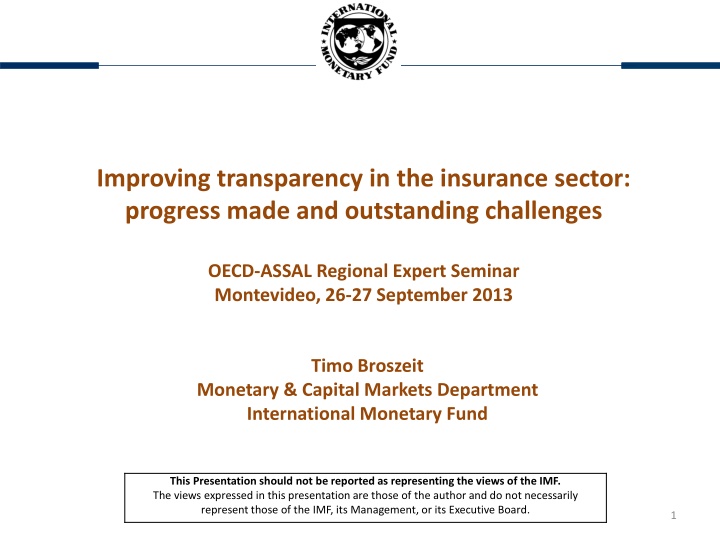Progress and Challenges in Enhancing Transparency in Insurance Sector
The presentation discusses the progress made and challenges faced in improving transparency in the insurance sector, highlighting the importance of the G20 Data Gaps Initiative. It covers the conceptual and statistical framework, data collection needs, and areas for enhancement to address risks in the financial sector. The initiative aims to strengthen data collection and reporting to better understand cross-border financial linkages, vulnerabilities to shocks, and improve communication of statistics for informed decision-making.
Download Presentation

Please find below an Image/Link to download the presentation.
The content on the website is provided AS IS for your information and personal use only. It may not be sold, licensed, or shared on other websites without obtaining consent from the author.If you encounter any issues during the download, it is possible that the publisher has removed the file from their server.
You are allowed to download the files provided on this website for personal or commercial use, subject to the condition that they are used lawfully. All files are the property of their respective owners.
The content on the website is provided AS IS for your information and personal use only. It may not be sold, licensed, or shared on other websites without obtaining consent from the author.
E N D
Presentation Transcript
Improving transparency in the insurance sector: progress made and outstanding challenges OECD-ASSAL Regional Expert Seminar Montevideo, 26-27 September 2013 Timo Broszeit Monetary & Capital Markets Department International Monetary Fund This Presentation should not be reported as representing the views of the IMF. The views expressed in this presentation are those of the author and do not necessarily represent those of the IMF, its Management, or its Executive Board. 1
Agenda Introduction G20 Data Gaps Initiative: Overview and Objectives G20 Data Gaps Initiative: Recent Progress Outstanding Challenges 2
Introduction Financial crisis made data gaps more obvious than ever Interconnectedness Liquidity Credit default swaps Cross-border exposures Risk concentrations Tail risks Real estate prices Public sector debt Leverage Derivatives 3
Agenda Introduction G20 Data Gaps Initiative: Overview and Objectives G20 Data Gaps Initiative: Recent Progress Outstanding Challenges 4
G20 Data Gaps Initiative: Overview April 2009: G20 Finance Ministers and Central Bank Governors call FSB and IMF to explore gaps and provide proposals for strengthening data collection October 2009: FSB/IMF set up list of 20 recommendations, endorsed by G20 Finance Ministers and Central Bank Governors Annual progress reports by FSB and IMF (most recent: September 2013) 5
G20 Data Gaps Initiative: Overview Conceptual / statistical framework exists and ongoing collection needs enhancement Conceptual / statistical framework needs development Build-up of risk in the financial sector #3 (Tail risk in the financial system and variations in distributions of, and concentrations in, activity) #4 (Aggregate leverage and maturity mismatches) #6 (Structured products) #2 (Financial Soundness Indicators (FSIs)) #5 (Credit default swaps) #7 (Securities data) Cross-border financial linkages #8 and #9 (Global network connections and systemically important global financial institutions) #13 and #14 (Financial and non-financial corporations cross-border exposures) #10 and #11 (International Banking Statistics (IBS) and Coordinated Portfolio Investment Survey (CPIS)) #12 (International Investment Position (IIP)) Vulnerability of domestic economies to shocks #16 (Distributional information) #15 (Sectoral accounts) #17 (Government finance statistics) #18 (Public sector debt) #19 (Real estate prices) Improving communication of statistics #20 (Principal global indicators) 6
G20 Data Gaps Initiative: Overview A myriad of institutions working on these recommendations: 7
G20 Data Gaps Initiative: Objectives Agenda with regard to insurance statistics: Recommendation #2: Expand list of FSIs, incl. non-banks Recommendation #3: FSIs - implementation of measures that cover tail risks, concentrations, variations in distributions, volatility of indicators Recommendation #4: FSIs - Develop measures of aggregate leverage and maturity mismatches in the financial system Recommendation #8: Interlinkages between SIFIs Recommendations #10 and #11: Coordinated Portfolio Investment Survey (CPIS) Recommendation #13: Cross-border exposures Recommendation #14: Standardized template covering international exposures of large nonbank financial institutions Recommendation #15: Sectoral accounts, in particular nonbank financial institutions 8
Agenda Introduction G20 Data Gaps Initiative: Overview and Objectives G20 Data Gaps Initiative: Recent Progress Outstanding Challenges 9
G20 Data Gaps Initiative: Recent Progress G-SIFIs: First template for G-SIBs finalized Phase 1 started in March 2013 (consolidated data on bilateral counterparty credit exposures and aggregated exposures) Phases 2 and 3 will progressively expand and enhance template Data hub at the BIS Cross-border exposures: Pilot exercise to set up an inventory of existing data on cross-border positions CPIS: Semi-annual (instead of annual) data collection since June 2013 10
Agenda Introduction G20 Data Gaps Initiative: Overview and Objectives G20 Data Gaps Initiative: Recent Progress Outstanding Challenges 11
Outstanding Challenges Expansion of FSIs which currently include: 25 indicators for deposit takers 2 indicators for other financial corporations assets to total financial system assets assets to GDP 5 indicators for nonfinancial corporations 2 indicators for households 2 indicators for market liquidity 4 indicators for real estate markets Quarterly reporting of FSIs Main challenge: which valuation framework? => comparison across countries difficult! 12
Outstanding Challenges G-SIFI data collection to include G-SIIs: Main challenge (again ): which valuation framework? => comparison across companies difficult! Finally, some remarks on confidentiality: Some reluctance with regard to sharing data with IMF, BIS and other multilateral institutions BIS data hub works under strict confidentiality safeguards Even data sharing at bilateral or regional level can improve supervision! 13
Outstanding Challenges (beyond G20 DGI) Consolidated data Highest level of consolidation, incl. (non-financial) holding companies Data sharing between home and host authorities Some more technical stuff: Interconnectedness with the banking sector Direct exposures (bonds, equity, deposits, repos ) Common exposures Asset-liability matching, interest rate sensitivities Technical provisions Risk mitigation (reinsurance, hedging, securitization) Modeling of catastrophe losses Pricing patterns and (re)insurance cycle 14
Outstanding Challenges Probably the biggest challenge 15
Questions? TBroszeit@imf.org 16























